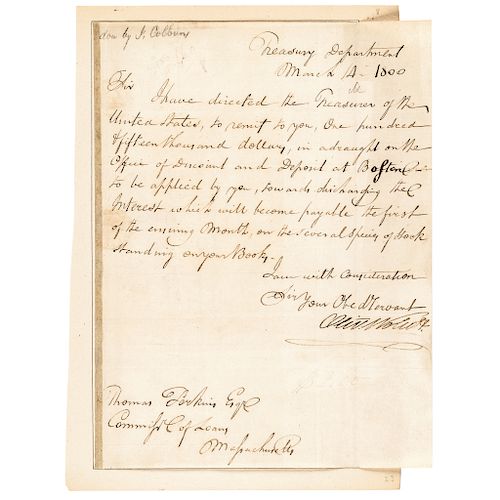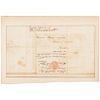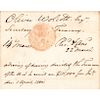1800 Oliver Wolcott Jr U.S. Treasury Secretary ALS Paying $115,000 Loan Interest
Lot 96
Estimate:
$900 - $1,200
Absentee vs Live bid
Two ways to bid:
- Leave a max absentee bid and the platform will bid on your behalf up to your maximum bid during the live auction.
- Bid live during the auction and your bids will be submitted real-time to the auctioneer.
Bid Increments
| Price | Bid Increment |
|---|---|
| $0 | $10 |
| $200 | $20 |
| $300 | $25 |
| $500 | $50 |
| $1,000 | $100 |
| $2,000 | $200 |
| $3,000 | $250 |
| $5,000 | $500 |
| $10,000 | $1,000 |
| $20,000 | $2,000 |
| $30,000 | $2,500 |
| $50,000 | $5,000 |
| $100,000 | $10,000 |
| $200,000 | $20,000 |
| $300,000 | $25,000 |
| $500,000 | $50,000 |
About Auction
By Early American History Auctions
Aug 24, 2019
Set Reminder
2019-08-24 12:00:00
2019-08-24 12:00:00
America/New_York
Bidsquare
Bidsquare : Autographs, Colonial Currency, Political Americana, Historic Guns
https://www.bidsquare.com/auctions/early-american-history-auctions/autographs-colonial-currency-political-americana-historic-guns-4347
Historic Autographs • Colonial Currency • American Civil War Colonial Era • Revolutionary War • Political Americana • Black History Early American History Auctions auctions@earlyamerican.com
Historic Autographs • Colonial Currency • American Civil War Colonial Era • Revolutionary War • Political Americana • Black History Early American History Auctions auctions@earlyamerican.com
- Lot Description
Autographs
Oliver Wolcott Jr. United States Treasury Secretary ALS Paying $115,000.00 of U.S. Loan Interest Debt at Boston
OLIVER WOLCOTT, JR. (1760 - 1833). American politician who served as the 2nd United States Secretary of the Treasury (1795 to 1800) after Alexander Hamilton and the 24th Governor of Connecticut 1817 to 1827).
March 14, 1800-Dated Federal Period, Autograph Letter Signed Twice, "Oliv. Wolcott" as Secretary of the United States Treasury,2 pages, measuring 7.25" x 9.75", with FREE Franked Integral Address Leaf, carefully tipped to a 7" x 10.75" presentation sheet with docket on reverse, Choice Very Fine. This fiscal payment of Interest on the Debt of the United States for April 1, 1800 at Boston. Very light early red Circular Postal Stamp in address panel next to recipient "Thomas Perkins Esquire, Commiss. of Loans - Boston". This early historic Fiscal Letter for the payment of such a large amount of Interest on U.S. Loan Debt reads, in full:
"Treasury Department - March 14-1800 -- Sir -- I have directed the Treasurer of the United States, to remit to you, One Hundred & fifteen thousand dollars, in a draught on the Office of Discount and Deposit at Boston - to be applied by you, Forward discharging the Interest which will become payable the first of the ensuing Month, on the several shares of stock standing on your Books. - I am with Consideration Sir Your Obed Servant - (Signed) "Oliv. Wolcott". Noted as addressed to: "Thomas Perkins Esq - Commiss. of Loans Massachusetts".
Extremely rare, written on clean high quality watermarked laid period paper, both signatures of Oliver Wolcott written in rich brown and very readable.
Beginning in 1789, Oliver Wolcott Jr. (b.1760 - 1833) played an important role in the organization of the nascent Treasury Department. First, as Auditor, he established its clerical forms and methods, and two years later, as Comptroller, he was instrumental in establishing the branches of Secretary Alexander Hamilton's First Bank of the United States.
In 1795 Wolcott was appointed by President Washington to be Hamilton's successor, continuing as Secretary under President John Adams. Charged with the task of raising revenue for the rapidly growing Federal Government, Wolcott constantly sought and received Hamilton's advice. As Hamilton's ally he faced difficulties in Congress, where Hamilton's opponent Albert Gallatin sought more congressional control of Treasury's financial policy. Wolcott resigned in 1800 under a storm of criticism from Jeffersonians in Congress. In reaction he invited a congressional investigation of the Treasury Department in 1801, which cleared his name.
Oliver Wolcott, Jr. was the new nation's second Treasury Secretary, the second of two men to serve in that position under President George Washington, and the first of two men to serve under President John Adams. Born in Litchfield, Connecticut in 1760 to a man who would later sign the Declaration of Independence, Wolcott graduated from Yale in 1778 despite serving in the Continental Army from 1777 to 1779. He later studied law and passed the bar in 1781 but spent much of the 1780s trying to disentangle wartime accounts. He became Connecticut's state comptroller in 1789, then moved to the new federal government, first as auditor, then as comptroller, and finally, after Hamilton's resignation, as Treasury Secretary.
With continued advice from Hamilton, Wolcott attempted to run small surpluses whenever possible and succeeded in doing so in 1796, 1797 and 1798, and ran an almost perfectly balanced budget in 1800. As a result, the nominal national debt was virtually unchanged over his tenure, starting at $83.76 million in 1795 and ending at $83.04 million in 1800. Because of the rapidly expanding and growing economy of the 1790s, however, the real national debt dropped from 22% to 17.5% of GDP during his term despite the fact that government expenditures as a percent of GDP grew from just under 2% to over 2.25% over that same span.
After leaving Adams's cabinet at the end of 1800 due to the withering attacks of Jeffersonians, Wolcott ran a mercantile operation in New York until retiring to his Litchfield farm in 1815. In 1817, he started a decade-long stint as governor of Connecticut, a position previously held by his father and grandfather. He died in 1833, the final surviving member of Washington's cabinet, in New York City but was buried in Litchfield.
- Shipping Info
-
Early American provides in-house worldwide shipping. Please contact us directly if you have questions about your specific shipping requirements.
-
- Buyer's Premium



 EUR
EUR CAD
CAD AUD
AUD GBP
GBP MXN
MXN HKD
HKD CNY
CNY MYR
MYR SEK
SEK SGD
SGD CHF
CHF THB
THB















